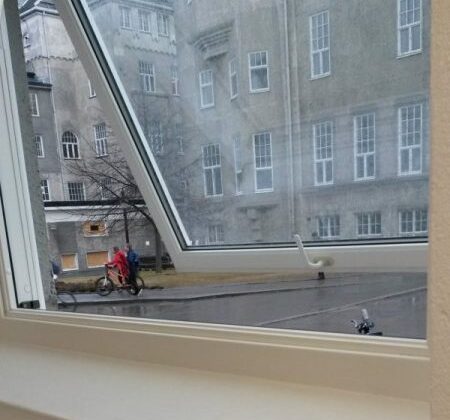Save money and the environment with smart heating controls

In order to stay warm, we usually require a certain indoor temperature all year around. This can get expensive in cold countries like Norway, not only for the household economy, but also for the environment. However, this might change with new, smart controls of heating systems.
The heating system of a building supplies heat to rooms and heats up warm water so that we can take a warm shower. The most common heating system for Norwegian residential buildings consists of electric radiators for space heating and an electric resistance heater to heat up domestic hot water. This is mainly due to electricity being cheaper in the past. In recent years, growing attention has been given to air-source heat pumps as a heating system for residential buildings.
So how does a heat pump work?
In principle, a heat pump works like your fridge, just the other way around. Instead of removing heat to keep the food cold, a heat pump adds heat to rooms to heat them up. An air-to-water heat pump usually provides heat to a water storage tank. This tank can be connected to a floor heating system that provides heat to rooms.
This type of heat pump typically has an efficiency (COP) of around 2 to 5 depending on the outdoor air temperature, whereas direct electric heaters always have a COP of around 1. For example, a COP of 3 means that for each 1 kWh of electricity that you supply to your heat pump, it provides 3 kWh of heat.
Best-case scenario: Without lifting a finger you can save money and the environment by consuming electricity during times with low electricity prices, or during times with low CO2eq. intensities of the electricity mix.
Saving energy with a flexible heating system operation

Room temperatures are usually controlled to keep a constant temperature set-point of 21 °C. However, allowing the set-point to fluctuate between, for instance, 20 °C and 23 °C is enough to operate the heating system in a more flexible way.
Any building that can store heat can be used to shift energy use in time, which is also called load shifting. Load shifting can be done by advanced controls, such as model-predictive controls or predictive rule-based controls. By actively varying the temperature set-points for heating, these controls can use fluctuating electricity prices or a time-variable CO2eq. intensity as a control signal.
The CO2eq. intensity of the electricity mix gives an indication of the fraction of renewable energies in the mix. A low intensity suggests that electricity is produced from renewables.
Even though most of the electricity in Norway is generated from hydropower, the CO2eq. intensity varies on an hourly basis. This is because Norway also imports electricity, especially during the night. The imported electricity is usually generated from fuels that are more carbon-intensive, for instance natural gas or coal. Thus, the CO2eq. intensity in Norway increases.
Model-predictive control and predictive rule-based controls can enforce the operation of the heating system during times of low electricity prices or low CO2eq. intensities of the electricity mix.
Best-case scenario: You can save money and the environment by consuming electricity during times with low electricity prices or during times with low CO2eq. intensities.
Maximizing cost and emission savings
A model-predictive control (MPC) can maximize cost savings or emission savings by adjusting a schedule for the heating system at every hour, knowing when the electricity price or CO2eq. intensity will be high, so that it can avoid heating during these times.
A predictive rule-based control is a little bit less flexible as it fluctuates temperature set-points based on pre-defined rules. These have to be designed carefully to reach desired results. This kind of control is closer to the state-of-the-art than MPC and can be more easily implemented into residential buildings.
Could become reality soon
In our project, we are working on predictive rule-based controls that are based on time-variable electricity prices and CO2eq. intensities. For this purpose, we are applying building performance simulation using the software tool IDA ICE.
Here, we can implement a detailed model of a heat pump system and study the effects of these controls on the operation of space heating and domestic hot water heating. Furthermore, we developed a methodology to calculate the hourly CO2eq. intensity so that we know when it is most environmentally friendly to operate a heating system. The application of these types of controls can become reality as soon as (a) smart meters are installed in buildings and (b) electricity providers offer tariffs with hourly-varying electricity prices to private customers.
If we achieve these goals, homeowners may be able to save both money and the environment without actually lifting a finger.
The blog entry is based on two scientific papers
- “Predictive rule-based control to activate the energy flexibility of Norwegian residential buildings: Case of an air-source heat pump and direct electric heating” by J. Clauß, S. Stinner, I. Sartori, L. Georges
- “A generic methodology to evaluate hourly average CO2eq. intensities of the electricity mix to deploy the energy flexibility potential of Norwegian buildings” by J. Clauß, S. Stinner, C. Solli, K.B. Lindberg, H. Madsen, L. Georges
Blog post originally published on www.ntnutechzone.no on March 17th, 2019

John Clauß
John Clauß is a PhD Candidate at NTNU – Department of Energy and Process Engineering. He is affiliated with the FME ZEN – The Research Centre on Zero-Emission Buildings, connected to WP4 on flexible operation.
Tags In
Search
Søk
Categories
- Arctic Research
- Arkitektur
- Bærekraft
- Bioingeniørfag
- Biologi
- Biology
- Biomedical Laboratory Science
- Biotechnology
- Bioteknologi
- Chemical Engineering
- Chemistry
- Climate
- Computer Science
- Datateknologi
- Digital
- Elektronikk
- Energi
- Energi
- Energy
- Engineering
- Engineering
- Environment
- Food Science
- Forskning
- Fysikk
- Fysikk
- Havbruk
- Informasjonsteknologi
- Informasjonsteknologi
- Ingeniørvitenskap
- Kjemi
- Kjemisk prosessteknologi
- Kjemisk prosessteknologi
- Kreftbehandling
- Kybernetikk
- Marine Technology
- Materialer
- Materials Science
- Materialteknologi
- Matvitenskap
- Meninger
- Miljø
- Min ph.d.
- My PhD
- My PhD
- My postdoc
- Nanotechnology
- Nanoteknologi
- Ocean
- Oil and gas
- Physics
- Research
- Simulering og visualisering
- Spør en forsker
- Studentliv
- Sustainability
- Ukategorisert
- Universitetsliv
- University Life
Kategorier
- Arctic Research
- Arkitektur
- Bærekraft
- Bioingeniørfag
- Biologi
- Biology
- Biomedical Laboratory Science
- Biotechnology
- Bioteknologi
- Chemical Engineering
- Chemistry
- Climate
- Computer Science
- Datateknologi
- Digital
- Elektronikk
- Energi
- Energi
- Energy
- Engineering
- Engineering
- Environment
- Food Science
- Forskning
- Fysikk
- Fysikk
- Havbruk
- Informasjonsteknologi
- Informasjonsteknologi
- Ingeniørvitenskap
- Kjemi
- Kjemisk prosessteknologi
- Kjemisk prosessteknologi
- Kreftbehandling
- Kybernetikk
- Marine Technology
- Materialer
- Materials Science
- Materialteknologi
- Matvitenskap
- Meninger
- Miljø
- Min ph.d.
- My PhD
- My PhD
- My postdoc
- Nanotechnology
- Nanoteknologi
- Ocean
- Oil and gas
- Physics
- Research
- Simulering og visualisering
- Spør en forsker
- Studentliv
- Sustainability
- Ukategorisert
- Universitetsliv
- University Life



